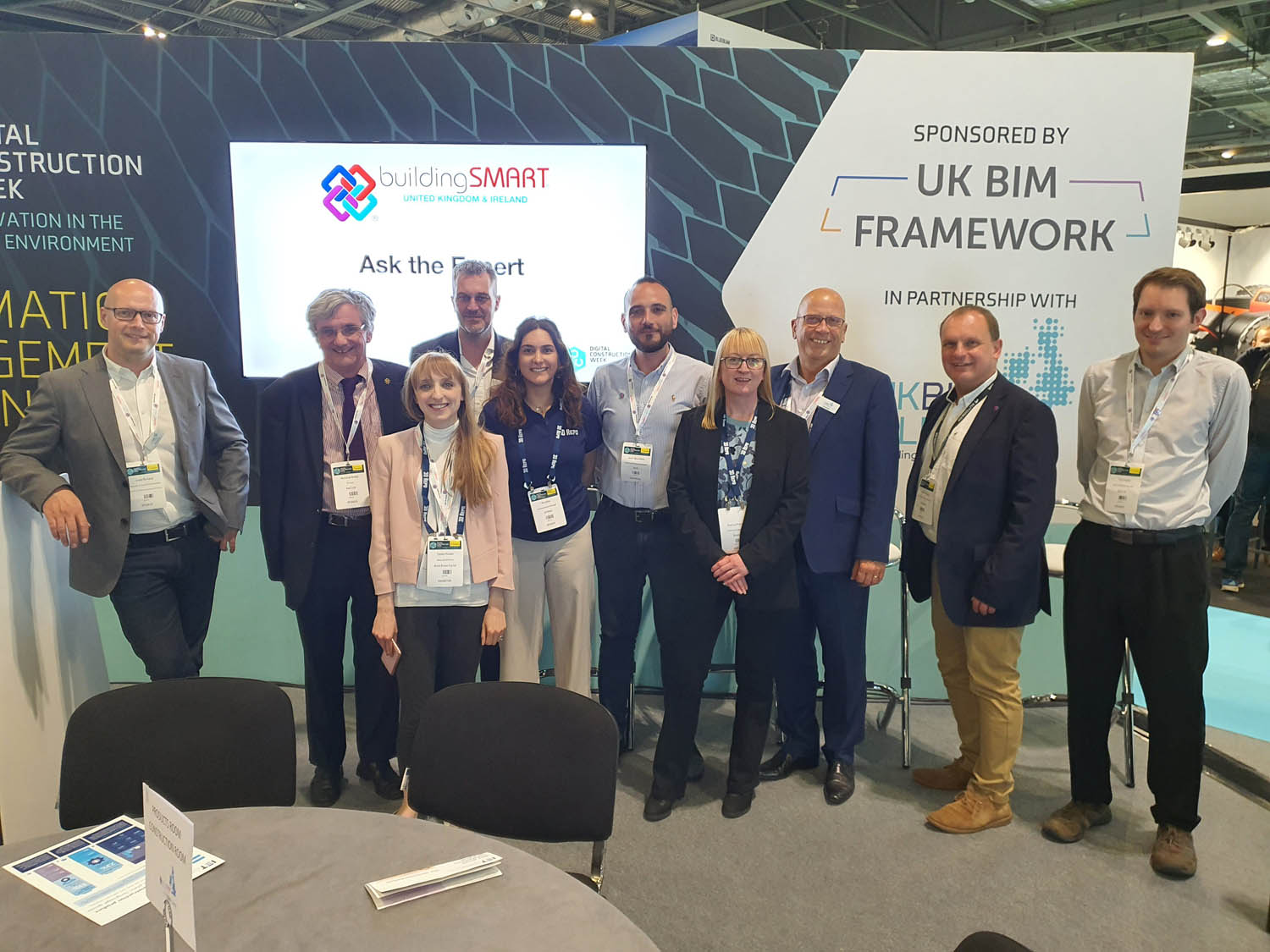Article #1 of 8 from AEC Magazine’s IFC Special Report
From sustainability to new business models, and from wellness to emerging technologies, IFC can be a force for good, driving the AEC industry to new levels of achievement, writes Casey Rutland, Chair of buildingSMART UK&I and founding director of Digital Green
There’s much to be said about convergence. In our particular sphere of influence, we’re living through a convergence of need, technologies and capabilities. It’s an exciting time to be influencing the direction of a sector.
There’s a lot of chatter online and in person about data, about IFC (Industry Foundation Classes), and about the challenges people are experiencing when it comes to data use and translation.
We say this is a good thing! If people are openly discussing the use of a globally recognised data structure for the built and natural environment (IFC), it means people are using it.
But many more could be using it, if only they were aware of its uses. It’s much more than a 3D model that you can open in different software. IFC is a data model, one that can be opened in a text editor, linked, interrogated and presented in many different ways to meet your particular use case.
To be serving this industry of ours as it undergoes this digital transformation is an honour. It’s exciting to be promoting better information management and the use of open standards to an industry where some are blissfully unaware of their existence. Every day, we can see the improvements that result from these efforts.
Where is the need?
The need is relative. It ranges from ‘I just want to finish my work and go home on time’, to ‘How can we meet the United Nations’ Sustainable Development Goals?’, and everything in between.
The need can be (and is) driven by individuals, projects, companies, industries, governments, economies and by nature.
Global awareness of the environmental challenges we’re facing, the pandemic we’ve all been living through and continue to deal with on a day-to-day basis, and the current increase in the cost of living are all issues that can be better understood and solved with data-driven decisions and actions.
The situation couldn’t be more urgent. Put simply, the time is simply not available for us to approach these challenges in an analogue manner. The need for us to use data to solve them is here, right now. But how do we create the data we need, ensure it can be trusted and use it positively?
When it comes to sustainability, it’s clear from many indicators that the industry – and society at large – is more aware than ever that we need to take immediate action. The impact our industry can have on this issue is huge. Data is needed across a vast range of topics in order to better understand how we can change and what the benefits might be. Whether it’s decarbonisation, material selection, post-occupancy evaluation, flood analysis, historic preservation or energy system specification, a standard data language reduces duplication, increases interoperability and standardises validation.
Using a standard data model approach means that the data we create is not locked into proprietary software, or indeed locked into one company’s systems. It can instead be exploited by other technologies for greater insight into built environment assets, helping to achieve better outcomes
In terms of health and safety, the recent Building Safety Act that gained Royal Assent in May, along with its accompanying secondary legislation, calls for information in a ‘golden thread’. During design & construction stages, information exchanges include the information (including evidence) relied upon to demonstrate that a building satisfies all the applicable building regulations. During occupation, meanwhile, the information relied upon in making the safety case and to demonstrate that building safety risks as defined are identified, will need to be exchanged, checked and managed.
Moving on from safety, wellness is an increasing concern. Particularly as we continue to emerge from the pandemic and into recovery, some organisations are now prioritising the health of their people and spaces. Through an ESG (environmental, social & governance) approach, data is central to providing and sharing the proof that their efforts are achieving the desired results. In doing so, these organisations are contributing to financial savings and wider benefits for the communities in which they operate.
Then there’s the economic climate and its impact on doing business. Material, product and energy prices are spiralling, making data not just a ‘nice to have’, but also an asset in itself. Data (and information management) is vital to the operation of any business. When treated as an asset, it can be linked and used throughout all business operations – providing clarity and offering the ability to make more informed decisions. Being able to interrogate IFC datasets across multiple projects to spot trends and to better quantify or calculate their impact, assured data can quickly prove its worth at an organisational level.
Finally, there are new business models to consider. If data is indeed the ‘new oil’ (or, as David McCandless puts it, the ‘new soil’), then being the guardian of valuable data offers the opportunity for traditional businesses in our industry to become more data-centric in the services they offer. Stepping into a new world of digital business models that exploit data and serve it to clients as insight is an option that would have previously been impossible. Structured data and information management is at the heart of that.

Technology Matters
In the construction and built environment business, the data model and schema used is called IFC. IFC is an international standard, ISO 16739, and is governed by buildingSMART International.
The IFC schema has been developed through an international effort over a period of 25 years, to achieve consensus about how assets are described and what properties are required to adequately describe them.
Emma Hooper explains more about IFC in her What is IFC? article
The risk of course, is that organisations beginning their journey are developing their ‘own’ data model – one that does not connect to others, one that is less secure and one that the supply chain would need to learn. From our point of view, this could be a disaster.
Using a standard data model approach means that the data we create is not locked into proprietary software, or indeed locked into one company’s systems. It can instead be exploited by other technologies for greater insight into built environment assets, helping to achieve better outcomes.
The proven ability of standards to generate trust is of utmost importance here. Our industry has a patchy history when it comes to trusting data and many are hesitant to rely solely on something they may not fully understand – even if they appreciate that it is ‘probably’ a better way of working. A transition period is required for familiarity to build and for trust to grow.
Many aspects of that trust lie in security – without a thought given to just how insecure some of our traditional working practices have been. People are quick to assume that ‘open’ data is somehow less secure. In reality, a standard data model will be more secure, given that security-sensitive data can be filtered (it’s always where it should be and easily searchable) and redacted prior to publication.
Open standards could also help companies in our sector to achieve their longer term technology ambitions. Sensors, apps, services, solutions and other inputs and outputs are being developed in initiatives (some may view them as silos) around our industry. The heavily invested-in worlds of proptech, contech, machine learning, artificial intelligence, digital twins, robotics and smart ‘things’ are all hugely active in our industry. Yet relatively few companies are aware of the rich stream of structured data that could help them develop much more scalable solutions.
Now is the time to act. We’re spreading the word to include these other digital transformation initiatives and helping to support their uptake.
But while general awareness is increasing, there’s still so much to do, so many more people to reach. In an ideal world, we wouldn’t need to work so hard at spreading the word. Professionals could simply go about their business and the technology would take care of the data side. But we’re not in an ideal world – not yet at least. And at the same time that we’re busy digitally transforming an industry, we’re also working hard to retain the hundreds of years of experience that already exists and ensure it gets passed on to the next generation of people and tools. In the software industry, the maturing understanding of OpenBIM benefits are also more apparent. There are open source applications being developed for all sorts of uses. For more on this, read Dion Moult’s article on BlenderBIM.
When it comes to individuals, our industry is fortunate to have many thought leaders, champions and grafters. I’m lucky enough to work with many of them in the buildingSMART UK & Ireland chapter. For those who want to demonstrate their experience and understanding of the whole process, professional certification is now available through approved training providers, delivering courses specific to the UK & Ireland market and with openBIM at their core. If you’d like to learn more, see Phil Read’s introductory article to certification.
Next steps
While the majority of people may first encounter IFC as a way of exchanging 3D model data in a construction project, they soon realise that the benefits are far wider reaching.
We recognise there are both perceived and real challenges in adopting an IFC approach. And we know we must continue to address these, by providing resources and help where we can. But we must also progress the discussion about data and its benefits in the short, medium and long term – that’s where the value lies.
As an organisation reaching out into industry, we do still see resistance to adoption in places, but there are also people and companies on their own OpenBIM journeys already making significant changes to their working methods. There are also pockets of excellence, with demonstrable proof in the buildingSMART International Awards submissions. You can see past finalists and winners in the yearbooks here.
So this is our call to action: Get in touch with us to discuss how IFC and OpenBIM can help you work more effectively, with better outcomes.
BuildngSMART UK&I would also like to thank everyone for their contributions to this IFC Special Report.
Click here for more information about buildingSmart UK & Ireland.
This article is part of AEC Magazine’s
IFC Special Report – Enabling interoperability in the AEC industry.
To read the other articles in this report click on the links below.
Inside buildingSMART
What is buildingSMART and what can it offer industry practitioners?
IFC: what is it and why is it needed
Emma Hooper, Associate Director and Head of R&D at Bond Bryan Digital, provides a useful overview of the IFC data model specification
IFC for Infrastructure
Perhaps the most significant update to the IFC standard is the inclusion of extensions for infrastructure entities in IFC 4.3
Native OpenBIM, and the rise of open source in AEC
OpenBIM can deliver on the promise of a digital world for the built environment where information and data are truly valued
IFC at Hinkley Point C
By Tim Davies, digital engineering manager, BYLOR JV – Hinkley Point C
Tackling the Gen Zero Project
The UK Department for Education’s Gen Zero project showcases how IFC can be used as the underlying data standard for a large, complex project, from start to finish
buildingSMART certification
By Phil Read, program lead at bSUKI and managing director, Man and Machine






